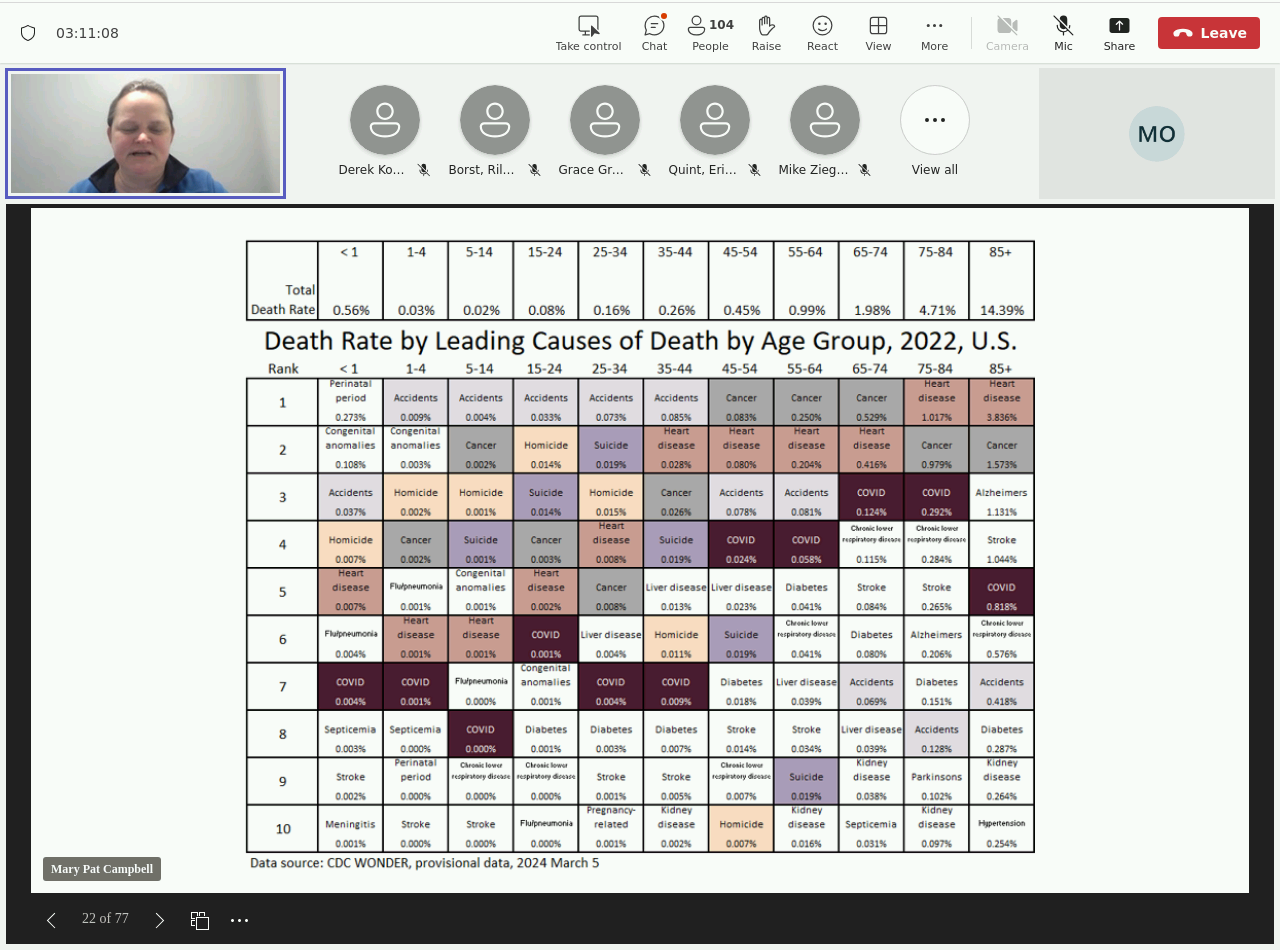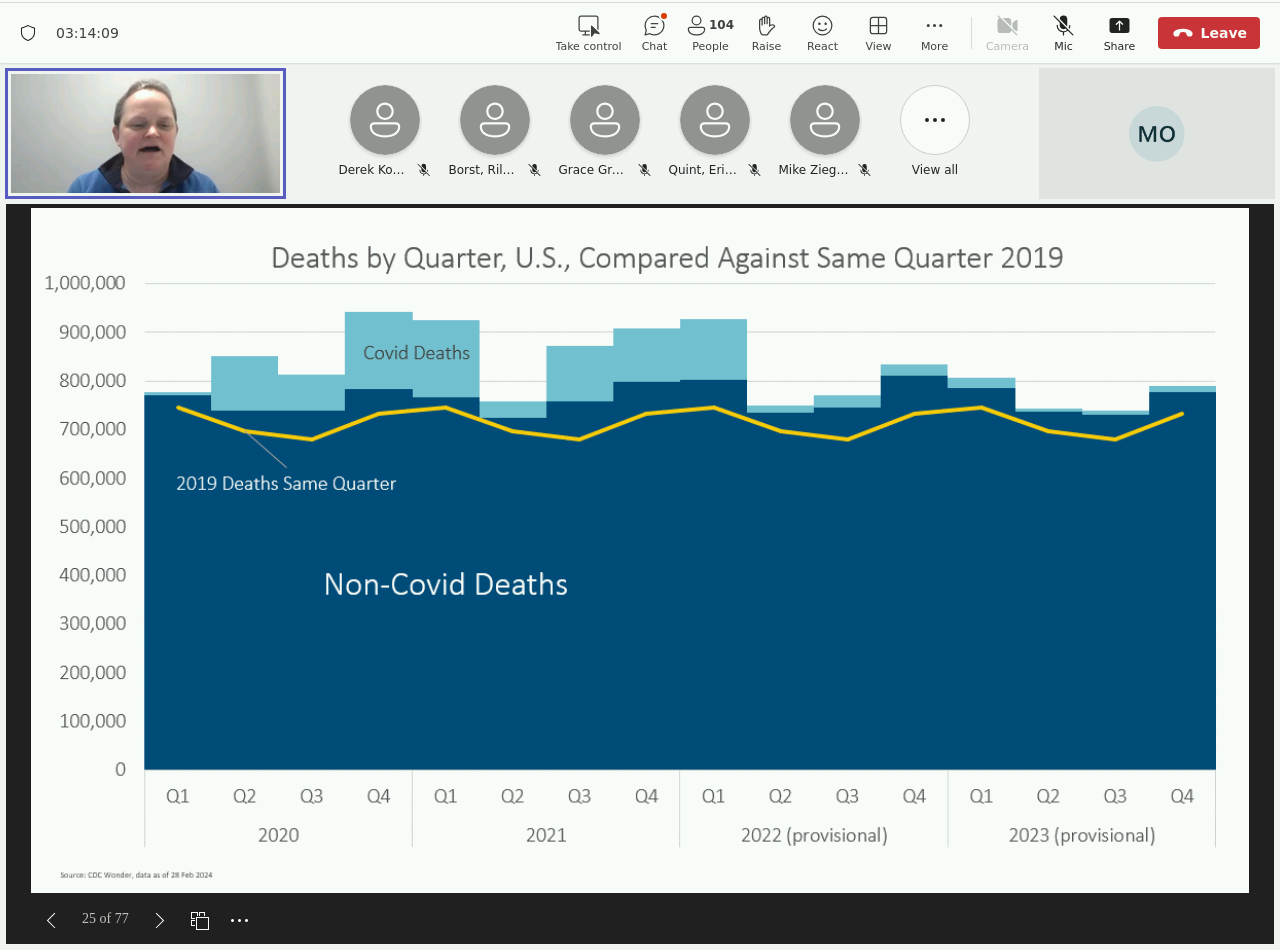U.S. Mortality in 2023: Continuing Updates
An AI-assisted summary of my talk, plus updated graphs
This is a continuation of my prior post from last week:
U.S. Mortality in 2023: Initial Updates
I would normally wait a few more weeks… but I’m giving a talk in a couple of weeks! I can’t wait! So let’s get cracking! Top-level mortality trends Note the distinction between crude death rate (which is just total deaths divided by total population) and age-adjusted death rate trend.
I put off updating my graphs as long as possible, because of the lag in reporting deaths… but I was giving my talk today.
The last data call I did on CDC Wonder was yesterday, and I even added slides this morning.
But I’m going to do this post in a different way….
Summary by Otter
I’m trying out something new in this post: I’ve been using Otter.ai to transcribe my and summarize online meetings for a year now. I just re-upped and upgraded my subscription yesterday.
This is the summary (and action items), and the only editing I did is to remove all the references to the two other sessions it also transcribed (which I attended for professional continuing education purposes - on actuarial use of LLMs by Dan Kim, and an actuarial professionalism session by Nancy Behrens).
I’m also grabbing the screenshots it took and selecting only a few of them to represent parts of the summary.
IAC Education Day: Room A
Mary Pat Campbell discussed mortality trends and causes of death in the US, presenting data on age-adjusted death rates, crude death rates, and external causes of death.
Action Items
[ ] Publish presentation slides and make available to attendees.
[ ] Send Otter.ai transcript of Room A session to Derek.
[ ] Distribute slides with links to additional resources to attendees.
[ ] Consider using Otter.ai to capture transcripts for multiple concurrent sessions next year.
[ ] Finalize 2022 mortality data and close data set.
[ ] Release updated mortality research reports with Tableau dashboards.
[ ] Send updated mortality presentation slides and spreadsheets to Derek for distribution.
Outline
Using AI tools for research and meetings.
Mary Pat Campbell's digital assistant attended a regularly scheduled Zoom meeting without her knowledge, sending her a summary of the meeting after the fact.
Mary Pat Campbell discusses using Otter for transcribing meetings and creating a knowledge base with Chat GPT for research purposes.
The evolution of actuarial work and technology.
Mary Pat Campbell reflects on how technology has transformed actuarial work, including the loss of junior clerical positions.
Mary Pat Campbell recounts her experience in trigonometry class, where she and her classmates had to do linear interpolation by hand without calculators, while some students relied on calculators for ease of calculation.
Campbell reflects on how the cost of calculation has changed over time, with modern technology making calculations seemingly effortless, but also highlighting the importance of thoughtfulness in calculation.
AI adoption in the insurance industry.
Mary Pat Campbell discusses using AI tools for idea generation and evaluation, with a focus on insurance industry use cases.
Mary Pat Campbell plans to send the transcript to attendees for feedback.
US population mortality trends, including data problems and pandemic impact.
Mary Pat Campbell discusses US population mortality trends and data problems with the CDC's 2022 data not yet finalized.
Mary Pat Campbell discusses provisional mortality data for 2022 and 2023, highlighting trends and comparisons to pre-pandemic years.
COVID-19 mortality rates in the US.
Mary Pat Campbell highlights 2023 COVID-19 death data, noting a 5-6% increase over 2019.
Mary Pat Campbell compares COVID-19 data in 2023 to the same period in 2019, showing a decrease in cases but a higher percentage of deaths among older populations.
Campbell highlights the impact of age and migration on COVID-19 mortality rates, noting that most deaths occur among people over 85 and that migrant populations are not a significant factor.
Mary Pat Campbell highlights the shape of mortality rates across different age groups.
COVID-19 mortality rates among different age groups.
Mortality rates for age 40-44 increased by over 40% in 2021 compared to 2019.
Mary Pat Campbell is concerned about a pattern of excess mortality among younger and middle-aged adults, particularly from external causes such as homicide, suicide, and accidents.
There is a 20% increase in deaths from external causes among young adults, with a high rate of drug overdoses and falls, and COVID-19 is a new factor affecting mortality patterns.
CDC data practices and external causes of death.
Mary Pat Campbell discusses CDC data practices and the impact of COVID-19 on death certificates.
Mary Pat Campbell reveals external deaths increased by 18% from April to July 2020, with continued growth in 2021 and 2022
.
Causes of death in the US, with a focus on COVID-19.
Mary Pat Campbell highlights key causes of death in the US, including heart disease, cancer, accidents, suicide, and homicide, with COVID-19 ranking lower in 2022 compared to previous years
.
Accidents, including drowning and motor vehicle accidents, are a leading cause of death for different age groups, while COVID-19 is more prevalent among older age groups and is not the top cause of death for males or females.
Mary Pat Campbell explains that the average number of causes of death listed on a death certificate has been rising due to people dying at older ages with multiple conditions.
Campbell uses underlying cause of death data to highlight the increase in heart disease deaths, particularly among those aged 85 and older.
COVID-19 deaths and major causes of death in the US.
Mary Pat Campbell discusses COVID-19 deaths by quarter, noting a significant drop-off in deaths in 2022 due to vaccination and comorbidities
.
Mary Pat Campbell notes a drop in cancer deaths and a rise in stroke, chronic lower respiratory disease, Alzheimer's, and diabetes deaths in 2022 and 2023.
Suicide, homicide, and accident deaths have increased since 2019, while heart disease deaths have improved.
Cancer and heart disease mortality rates during pandemic.
Mary Pat Campbell discusses cancer and heart disease mortality rates in the US, highlighting inconsistencies in CDC WONDER data and the need for further investigation
.
Mary Pat Campbell shares insights on how to approach data analysis during the pandemic, emphasizing the importance of understanding data issues and caveats.
Mary Pat Campbell explains that the population estimates in her research are based on the faulty census estimate of the time, and she wants to avoid adjusting them every time she does a data draw.
Campbell discusses how the estimates were miss-estimated due to an undercount of people living in Group Quarters, particularly nursing homes, and how this affected the older age groups.
Causes of death trends in the US from 2020 to 2023.
Mary Pat Campbell highlights patterns in mortality rates for various causes, including stroke, chronic lower respiratory disease, flu/pneumonia, and diabetes
.
Mary Pat Campbell notes a 20% increase in deaths from 2020 to 2022, with a provisional decrease in liver disease deaths
.
Mortality trends and insurance industry response.
Mary Pat Campbell notes a significant increase in drug overdose deaths among young people, particularly those aged 15-39, with a 60% increase in 2021 and 2022 compared to 2019.
Campbell also highlights a spike in motor vehicle accident deaths among the elderly, with a 20% increase in 2020 and a 10% increase in 2022 compared to 2019, suggesting that lockdowns and reduced mobility may have contributed to the trend.
Mary Pat Campbell discusses the increasing mortality rates in the US, particularly among certain age groups and socioeconomic levels.
Campbell highlights the Insurance Collaboration to Save Lives, a nonprofit organization she is involved with, which aims to address the issue by bringing together professionals from the insurance industry and other fields.
Trends in mortality rates and preventable deaths.
Speaker 2 shares their engagement with the topic of mortality trends, mentioning surprises in improvement areas such as childhood cancer and accidental deaths.
Speaker 2 highlights the long-term trend of lung cancer decreasing, while pancreatic cancer is increasing, despite expecting the opposite.
Mary Pat Campbell discusses the importance of tracking lightning strikes and preventable deaths, mentioning that a former National Weather Service employee tracks lightning strength as a hobby.
Campbell shares her own experience with vitamin D deficiency and how it can be easily addressed through consulting with a doctor and taking supplements.
Mary Pat Campbell provides valuable insights into the process of updating death data, including the frequency of updates and the importance of waiting for complete data.
Mairy Pat Campbell shares her experience with using the CDC's WONDER database and how she waits for provisional data to become finalized before analyzing it.
Some Notes
Some of the summarizing points are misleading. COVID-19 mortality is not 5 - 6% higher in 2023 than in 2019. It’s infinitely higher, officially. COVID-19 kept creeping into the summary in places where I never mentioned it.
All-cause mortality was 5 - 6% higher in 2023 than in 2019.
This is one of the weaknesses of the AI tools out there — they are fairly good at processing language, but still weak on precise statements. Some of the sentences above made no real sense at all.
That said, when it comes to high-level concepts, I found it useful in capturing the essence.
And, frankly, if it’s not capturing the essence, I’m almost definitely not communicating clearly.
So I was very happy to see many of the above summarizing points, while not giving any precise numbers, did give the qualitative trend I wanted to communicate.
“Speaker 2” above…. is me.
I was getting hoarse near the end of the session, and Otter didn’t perform as well when my voice quality changed. A human would not have gotten confused as to who was speaking — I was on camera and the continuous flow of speech from me did not ebb.
Humans tend to be multimedia synthesizers, and while we can be fooled (as with lip sync videos), many of us use multiple sensory cues to knit information together. I assume the systems may get there eventually.
Don’t worry, I won’t be using Otter to do too many of these — I just wanted to see what it would do for one of my talks. Some of it was good, but it still needs more editing.
Slides and DropBox Link
DropBox link to download spreadsheets and slides












